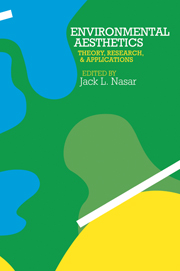Book contents
- Frontmatter
- Contents
- List of figures
- List of tables
- List of contributors and participants
- Acknowledgments
- Preface
- Section I Theory
- Section II Empirical studies
- Section III Applications
- Editor's introduction
- 27 Visual needs in urban environments and physical planning
- 28 A survey of aesthetic controls in English speaking countries
- 29 Scenic-beauty issues in public policy making
- 30 Coping with aesthetics and community design in rural communities
- 31 Toward theory generation in landscape aesthetics
- 32 Aesthetic regulation and the courts
- References
- Index of authors
- Subject index
32 - Aesthetic regulation and the courts
Published online by Cambridge University Press: 05 September 2013
- Frontmatter
- Contents
- List of figures
- List of tables
- List of contributors and participants
- Acknowledgments
- Preface
- Section I Theory
- Section II Empirical studies
- Section III Applications
- Editor's introduction
- 27 Visual needs in urban environments and physical planning
- 28 A survey of aesthetic controls in English speaking countries
- 29 Scenic-beauty issues in public policy making
- 30 Coping with aesthetics and community design in rural communities
- 31 Toward theory generation in landscape aesthetics
- 32 Aesthetic regulation and the courts
- References
- Index of authors
- Subject index
Summary
Introduction
This paper is an attempt to clarify developments in the land-use area for scholars in the field of environmental psychology as well as for others interested in the relationship between research on visual quality and the impact of that research on the judicial system. On the whole, this paper does not present major new factual findings, but argues for better understanding of the ways in which courts make decisions in this important area. It examines the development of the concept of public purpose in zoning as it is used in issues related to aesthetics and finishes by considering how the results of research in aesthetics can be used by courts and local governments in making decisions.
The Supreme Court and the concept of public response
The concept of public purpose is important in zoning and land-use decision making because it determines the extent to which government can have an impact on the private decisions of landowners and land users. The issue of public purpose goes all the way back to the landmark case of Euclid v. Ambler Realty Co., 272 U.S. 365 (1926), in which the Supreme Court of the United States upheld the power of local communities to zone land. From the time of that case to the present, there has been a clear, if not always steady, march to an expanded concept of the police power.
In Euclid, the Court upheld the use of zoning as being related to problems of public welfare on what, today, seems like a rather narrow basis.
- Type
- Chapter
- Information
- Environmental AestheticsTheory, Research, and Application, pp. 476 - 492Publisher: Cambridge University PressPrint publication year: 1988
- 4
- Cited by

